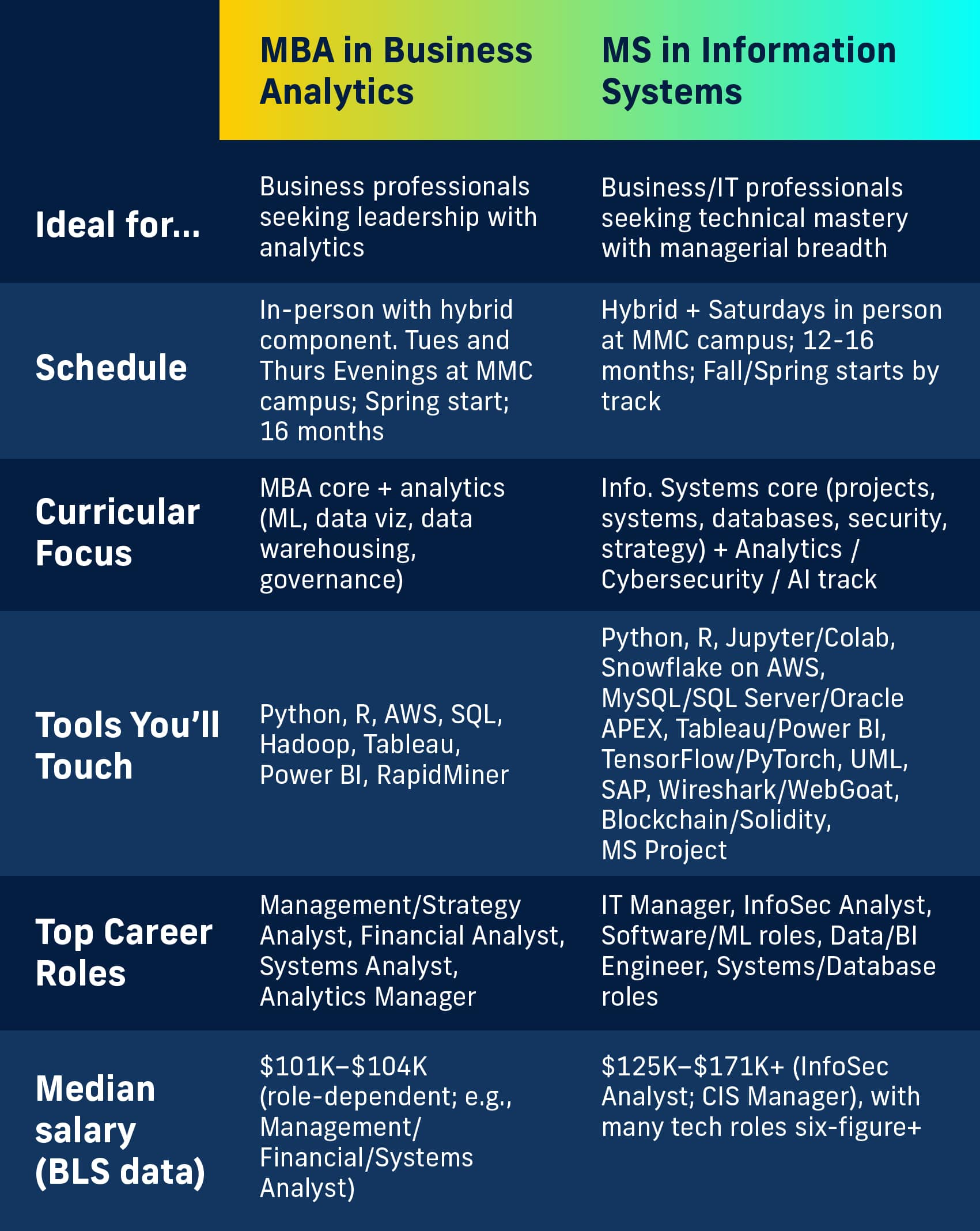Many business professionals drawn to the data + tech side of business compare FIU’s MBA in Business Analytics (MBA-BA) with our Master of Science in Information Systems (MSIS). Both are STEM-designated, both open doors to data-driven roles, and both position you for long-term growth. The better choice depends on whether you want to lead with analytics or build and manage the tech behind it.
Let’s break it down.
Program Overviews
MBA in Business Analytics
Format and pace. 16 months; in-person with a hybrid component at FIU’s Modesto A. Maidique Campus; spring start. You’ll complete 15 courses (45 credits) combining the MBA core (leadership, finance, marketing, strategy, etc.) with an analytics concentration.
What you’ll learn and use. You’ll turn complex data into business decisions while getting hands-on with:
- Programming and cloud: Python, R, Amazon Web Services
- Data stack: SQL, data warehousing, Hadoop
- BI and viz: Tableau, Power BI
- Data mining/ML tools: RapidMiner
Plus, you’ll work with real-world datasets from Fortune 500 companies and build communication, storytelling, and presentation chops for stakeholder impact.
MS in Information Systems (MSIS)
Format and pace. 12 - 16 months; hybrid delivery with Saturday classes on campus; fall or spring start depending on track; cohort-based.
3 Specialized Tracks to Choose From:
- Business Analytics (16 months; fall start)
- Business Cybersecurity (16 months; fall start)
- Artificial Intelligence (12 months; spring start)
What you’ll learn and use. A manager-plus-technologist skillset across systems, databases, project management, and emerging tech, with extensive tool exposure such as:
- Data/AI: Python, R, Jupyter/Colab; ML toolkits (TensorFlow, PyTorch); generative-AI integrations
- Databases and cloud: MySQL, SQL Server, Oracle Cloud APEX; Snowflake on AWS; data lakes and cloud warehousing
- BI and viz: Tableau, Power BI (incl. AI-assisted viz)
- Process and design: UML tools (Lucid, Visual Paradigm); business process modeling
- Security: Wireshark, WebGoat, Security Onion
- Other platforms: ERP/SAP, Microsoft Project, Scrum workbook, Blockchain/Solidity
Capstone and think-tank experiences connect you with real organizations and industry mentors (CIOs/CISOs) for applied projects.
STEM and OPT. Both programs are STEM-designated (international students may qualify for OPT + STEM OPT extension). OPT (Optional Practical Training) is temporary F-1 work authorization in your major field; STEM grads may be eligible for a 24-month extension after the standard 12 months.
Who Thrives in Each Program
- MBA in Business Analytics: You already operate in business contexts and want to lead teams, products, or functions using analytics as your edge. You’ll speak the language of executives and analysts.
- MS in Information Systems: You’re comfortable getting technical (or eager to be) and want to design, secure, or operationalize the systems, data pipelines, and AI solutions leaders rely on.
Career Paths and Salaries (BLS)
MBA in Business Analytics - common roles
- Management Analyst / Strategy and Ops Analyst - Median pay: $101,190
- Financial and Investment Analyst - Median pay: $101,350
- Computer Systems Analyst (for analytics-enabled systems roles) - Median pay: $103,790.
MS in Information Systems - common roles
- Computer and Information Systems (IT) Manager - Median pay: $171,200
- Software Developer / QA / Tester - Median pay: $131,450
- Information Security Analyst - Median pay: $124,910
Overlapping roles both degrees can target (skill-dependent)
- Data Scientist / Advanced Analyst - Median pay: $112,590
MBA-BA grads bring business framing + stakeholder leadership; MSIS grads bring modeling/ML and data engineering depth. - Operations Research / Decision Science Analyst - Median pay: $91,290
Great fit for analytics + optimization savvy professionals in either path. - Database Administrator/Architect / BI Engineer - Median pay: $104,620 (DBA) and $135,980 (DB Architect)
Toolsets overlap with both curriculum (SQL, cloud DW, Snowflake, BI).
Note: BLS medians are national figures; your actual compensation varies by metro, industry, experience, and certifications.
Salary and Growth Potential (Big Picture)
Both programs feed into six-figure career paths with strong growth. Management/strategy analytics roles (e.g., management analyst) are projected to grow ~9% (2024–34), faster than average. Tech leadership roles (CIS managers) are projected to grow ~15%, and software/security roles remain much faster than average.
Side-by-Side Comparison

The Takeaway
- If you see yourself leading teams and initiatives where analytics informs strategy and change management, the MBA in Business Analytics program is your lane.
- If you want to design, secure, and scale the systems, data pipelines, and AI that power modern businesses, the MSIS program will feel at home.
Either path builds in-demand skills, competitive salaries, and momentum for business professionals, whether you want to pursue more analytical roles or bridge the gap between business and IT.


